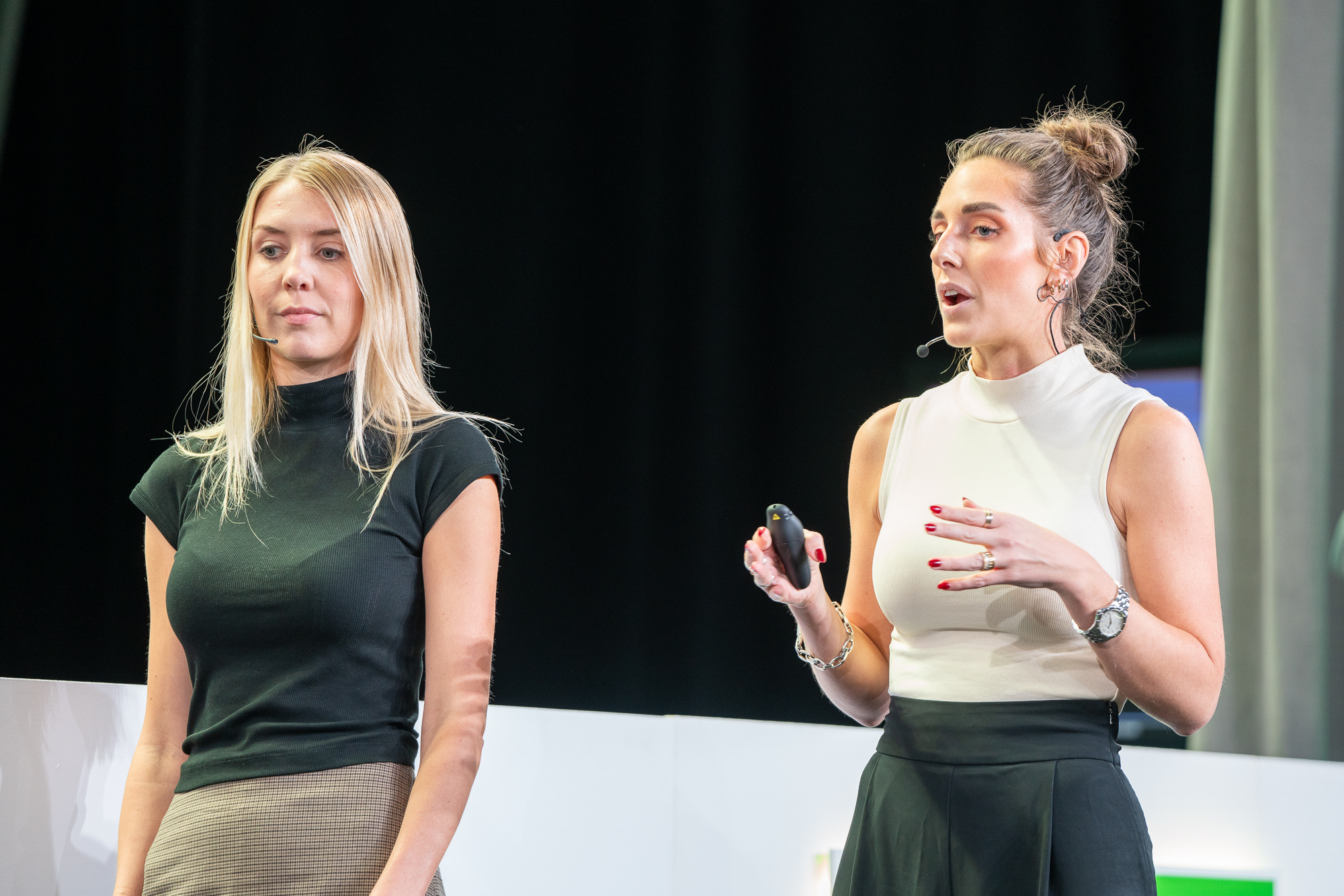Quantified health activity is all around us these days, as scores of people use mobile sensing technologies to keep an eye on their well-being by tracking their steps, workouts and even how long and deep they sleep — so why shouldn’t women who cycle (as in menstrual cycle) track monthly changes to their hormone levels? London-based femtech, Hormona, which is pitching its hormone tracker in the Startup Battlefield at TechCrunch Disrupt, hopes to encourage people with periods to do just that: Add hormone-monitoring to their quantified health mix.
Today it’s announcing the launch of its app in the U.S. after a period of early testing with “a few thousand” women in Europe (it’s been beta testing in Sweden). The 2019-founded U.K. startup has already spent a couple of years in R&D developing an easy-to-perform, proprietary at-home hormone test to underpin a forthcoming monthly subscription business that will enable users of its (freemium) app to pay to regularly test and report their hormone levels.
In the near future, in return for “roughly” $40 per month (for the subscription package which includes a supply of self tests), paying users will get feedback on whether they’re inside or outside the normal hormonal range for women their age — and suggestions for treatments if something looks amiss.
That’s for starters. Hormona’s overarching goal, as is often the case with femtech startups, is to encourage a critical mass of users to get on-board with a mission to help plug the data gap that persists around women’s health (as a result of medical research being historically skewed towards male biology) — by agreeing to pool data for research aimed at improving understanding of the roles hormones play in areas like fertility and the menopause. (This side is of course optional: Hormona confirms that any studies it engages in involving user data will be consent-based, i.e. requiring the user to opt their information in.)

Jasmine Tagesson, COO at Hormona pitches as part of TechCrunch Startup Battlefield at TechCrunch Disrupt in San Francisco on October 18, 2022. Image Credits: Haje Kamps / TechCrunch
“As of now, there isn’t enough data around hormonal health and it’s really affecting every single woman in different stages of her life so it’s a very important topic that we really need to spend more time to do more research and understand,” says Hormona CEO and co-founder, Karolina Lofqvist, ahead of today’s on stage pitch at the Startup Battlefield in San Francisco.
“With this test we can really help women to figure out if they have irregular cycles, if they’re going to have problems getting pregnant or if they’re going into menopause,” she continues. “Our full solution is really on hormonal health — and follow[ing] a woman from her first cycle all the way to her last.”
“We are hoping that with the data [users opt in] we can do more studies around how women are affected by their hormones, how different connections and different levels between hormones can be connected to hormone related issues such as PCOS [polycystic ovary syndrome] or — eventually, perhaps — endometriosis as well, even if it’s not a direct hormonal issue. But PCOS for sure, and infertility and menopause,” she adds. “There are a lot of things that are connected to your hormones that are currently understudied that we are very excited to do more studies and bring more awareness around.”
The startup has raised a total of $1.5 million in early backing from three VC firms so far: SFC Capital and Nascent Invest, as well as Techstars — after going through the latter’s LA accelerator program earlier this year.
Cycling through hormone testing
Hormona’s at-home hormone tests — which are lateral flow, urine-based tests for (initially) three separate hormones (FSH; progesterone; and estrogen) — will be available from Q1 next year, per Lofqvist, starting in the U.S., with a European launch to follow later.
That means, for now, its (free-to-download) app is essentially a general resource that provides information about the function of different female hormones. As tests become available, it’s also designed to funnel users towards regular self-testing (and paying a subscription) to unlock personalized hormonal insights once the testing component of the business launches early next year.
“In the app today you can start to understand what is supposed to happen with your hormones and then when the test is available women can confirm that what is supposed to happen is actually happening,” says Lofqvist, going on to explain that subscription users will be testing roughly one hormone per week (using a separate test per hormone) and doing this at home — “without the need for a lab”.
The three hormones it’s selected for testing were picked because they’re “connected to so many different issues that we women go through”, she says, adding that they may add tests for more hormones in the future — with testosterone and cortisol being two others of potential interest.
The initial batch of hormone tests are performed by users as three separate tests, rather than being bundled onto a single test strip. This is because Lofqvist says that certain hormones need to be tested on certain days to properly understand how levels are changing throughout the cycle. “You don’t test your estrogen on the same day as you test your FSH,” she notes, adding of the individual test dates: “It’s based on our algorithms telling when your estrogen and FSH is supposed to be at the highest or lowest level.”
App users need to provide Hormona with some information about themselves (such as their age) and about their cycle (e.g. regular or irregular; and its length) in order that it can calculate personalized testing dates. Lofqvist confirms these dates “can vary a bit” depending on what the user’s goal and age is. While she tells us the overall accuracy of its hormone tests is “on par” with an at-home blood test.
“We’ve spent the last two years in order to evaluate antibodies to give us as good result as possible and right now we are on par with at-home blood test,” she tells TechCrunch, adding: “But that’s something we continue improving.” (We asked for — but Lofqvist was unable to provide as yet — data on how its at-home hormone test compares in accuracy to a lab-based hormone test. So that’s one to watch for sure.)
So how does its at-home test work? Users take the specified hormone test in the morning on the day the app instructs them to by peeing on the test stick and using the app to scan the result with their mobile phone camera to get what Lofqvist describes as “a quantitive result within 15 minutes”. The test result takes the form of a couple of lines appearing on the strip. Hormona’s algorithms work by comparing the intensity of these lines in order to determine the amount of hormone in the user’s urine.
“If you compare it to a COVID-19 test, you don’t want to have two test lines — but we always have two tests lines,” she notes. “With the two tests lines we then compare the intensity in the test lines to provide a quantitive result for imaging processing.”
Lofqvist argues that by being able to test hormones levels multiple times, i.e. as the months of usage go on, it has the chance to glean a better understanding of hormonal changes because the tech can pick up on patterns over time vs the traditional hormone-testing route of going to a doctor/lab and getting blood drawn which is obviously also a lot less convenient. (Although the accuracy of Hormona’s at-home tests vs a blood-based hormone test performed by a professional needs to be properly factored into any comparison.)
“Today’s solution where you go to draw blood… doesn’t really tell you what is going on with your hormones because in order to understand it you need to test it multiple times in order to see the patterns and that is really what we want to try to achieve with our solution,” she suggests.
Hormona will be recommending users subscribe for at least three months — in order to get what Lofqvist calls your hormonal “baseline” — although she says they’re hopeful that women will see the value in continuing to shell out for a subscription to keep tracking these chemical signals on an ongoing basis, much like they might track their steps or sleep. (And exploring how the product might usefully integrate with other trackers and biomarkers, such as those from wearables or other health tech gadgets, is something she says they’re looking at.)
“As a woman, some months you may have been stressing more — which increases your cortisol and can affect your hormones — so in order to figure out what’s going on you need to test for at least three cycles. After three cycles we can give you then some indication of what’s going on with your hormones. And give you a treatment plan based on your hormone levels,” she notes.
“When it comes to women that are a bit younger it tends to be holistic treatment plans — in order to stabi

Karolina Lofqvist (CEO) and Jasmine Tagesson (COO) at Hormona pitch as part of TechCrunch Startup Battlefield at TechCrunch Disrupt in San Francisco on October 18, 2022. Image Credits: Haje Kamps / TechCrunch
lize your hormones — but we also are in discussions with medical providers that can provide medication to women that are in need of it if you, for example, are going into menopause quite early or if you have issues around your menopause.”
Why track hormones?
While it’s easy to see utility in ongoing, regular hormone tracking for women suffering from specific health issues that they already suspect might be linked to a hormonal imbalance, why should women generally be wanting to track their hormones? What utility can people who cycle get from paying to access this sort of data on an ongoing basis, as Hormona hopes they’ll be persuaded to?
Lofqvist responds to this by recounting her own story of hormone-related health issues — which led her, ultimately, to a diagnosis of imbalances and an under-active thyroid. But it was the difficulty she had obtaining this diagnosis through traditional healthcare routes, and the stress and frustration of her experience with these conventional channels, that sealed her conviction there’s broad value for women to track their own hormones. ‘Knowledge is power’ and all that.
“The reason why I started Hormona was due to my own health issues. I used to work in an investment fund and work quite long hours. I went to multiple doctors because I suddenly started to lose hair, getting brain fog, gaining weight. And a lot of doctors said that it was probably due to stress and I should try taking anti-depressants,” she recounts. “It wasn’t until I found a hormone specialist in Brussels that had me take weekly blood tests in order to figure out how my hormones were fluctuating that he realized I was suffering from hormonal imbalances.
“And it is very common today [for women to have hormonal imbalances]. But today’s solution of drawing blood — one blood test — can’t really tell you what’s going on with your hormones. So the reason we have picked those three hormones is they are really the key hormones when it comes to a lot of issues that women are going through that are currently understudied that we are hoping we can bring more data and medical research around.”
She also says Hormona’s start point is a list of around 50 symptoms that can be related to hormonal imbalances, such as weight gain, acne, brain fog, hair loss and so on; and its initial target are women who can “connect” to those symptoms and who are interested in investigating possible underlying causes.
“There are a lot of symptoms that are related to hormonal imbalances. And what we can see from our user base today is it’s mainly women around late 20s to early 40s that are very interested in the concept — but as we go [on] we really want to follow women from her first period all the way to her last with all the hormonal changes that she’s going through,” she adds.
If the app picks up something out of the normal range as the user performs regular testing — such as them having too much progesterone or too much estrogen vs the standard for their age (something which might be the result of them having been on hormonal contraception and then stopping it, for example) — it will suggest what Lofqvist describes as a “holistic treatment” plan.
She says these personalized plans are based on existing scientific research into interventions that may be beneficial for hormonal imbalances — in areas like diet, exercise or taking certain supplements.
“Quite often there are a lot of holistic treatments that can help women to stablize their hormones if they are at a younger age,” she suggests, pointing to “a lot of studies based on that” — and noting that such treatments worked for her when she was suffering hormone-imbalance related issues in her twenties.
Hormona’s technology is not yet regulated as a medical device but Lofqvist confirms that is the goal, telling us: “We have a very clear regulatory path that we have developed over the last year where the end goal is to have an approved medical device.”
For older women, the intended product utility includes being able to help them identify when they’re entering the menopause — based on spotting changes to their hormonal baseline. And perhaps picking up that change happening earlier than they otherwise might.
“Today there isn’t really any test that tells a women they’re going into menopause,” she argues. “A lot of doctors say you need to wait for a year to see if you haven’t had your period for a year then you’re considered going into menopause. But with our test we can quite quickly see that you’re going into menopause when your estrogen is dropping and your FSH is going up. So there is quite [a lot of] use-cases around these three hormones but, to start off, we’re focusing on hormonal imbalances and use that to improve the general well-being of a woman.”
“As we go, the more data that we collect we really hope that we can really fill the medical landscape and help to guide the future of hormonal health,” she adds. “Because it is really understudied, under-utilized and under-funded.”
Competitive and challenging landscape
This isn’t the first quantified health startup we’ve seen that’s using urine testing as the method for acquiring biomarker data. Indeed, the health alert potential of pee-testing has been interesting startups for years (both for highly targeted and far broader health concerns) — and it’s easy (pee-sy!) to see why since it’s a straightforward, minimally invasive/low mess method that can quickly be incorporated into a morning bathroom routine.
Nor is Hormona the first femtech startup to be inspired to productize at-home hormone testing — with the likes of Berlin-based Inne (saliva-based testing) and Modern Fertility (finger prick tests) also in the game, to name a couple of rivals (albeit, the latter sold to telemedicine giant, Ro, back in 2021).
But a lot of femtech plays around hormonal health are targeted at specific issues and/or conditions — such as Allara, another recent U.S. startup, that’s focused on support for PCOS, for example — rather than trying to center hormone tracking itself to sell the idea of ongoing testing as a useful ‘well-being’ signal.
Lofqvist sums its positioning up by saying Hormona’s “pure focus is on hormonal health”.
She has some warm words for fellow European startup Inne, when we bring up its competing (saliva-based) at-home hormone test (which involves an additional piece of hardware that carries out the at-home analysis). But she argues there are key differences in product focus and output — with, for example, Inne targeting fertility (it had planned to prioritize a contraceptive use-case but that got delayed after the pandemic disrupted a major study it needed to support its application for regulatory clearance).
She also points out that Inne provides users with less quantitative results (hormone levels are reported more abstractly; such as low, high etc.) versus Hormona (which reports actual numerical values). While Inne has always avoided describing its product as a hormone tracker, per se — instead its marketing talks of its product as a “cycle- and ovulation-tracker” (which is narrower than Hormona’s broader quantified health push). Plus it’s not testing all the same hormones. So the product positioning between that particular pair looks fairly distinct.
In general, Hormona is gearing up to go after a broader ‘female wellness’ use-case vs other femtechs interested in investigating hormones. Although its challenge is therefore broader: Its “hormonal health” premise is about connecting with a wider user-base by convincing women there’s general utility in making time to keep tabs on their monthly hormone levels and being curious about how they compare with their peers.
Early interest in its product has come from women who have been “dismissed by their doctors”, per Lofqvist. “Just like me they’ve been trying to figure out what’s going on with their health,” she tells us. But she points to signs of broader interest, too: “As of now we have women that are not suffering as well — they just wants to understand what is supposed to happen with their hormones on a daily basis and how you can kind of optimize your well-being.
“For example we had one woman that wrote a really nice review the other day that was like ‘oh I’m so grateful that a hormone app told me that today you may suffer from PMS [premenstrual syndrome] in the days before my menstrual cycle because otherwise I thought that I was just depressed. So to just get that small awareness that it’s actually normal the way you’re feeling, due to your hormones, feels like a big relief for a lot of women.”
“I think it’s amazing that there are so many femtech companies popping up and booming right now — it’s just helping everyone,” Lofqvist adds. “There is a lot of companies around fertility and menopause but what we want to focus on is purely hormonal health and carve out this new space that serves as its own category where we can follow women from her first period all the way to her last with all the changes that she’s going through.”
Why should women not want to track their hormones? Well, one very big red flag for potential users in the U.S., specifically — which might give women there reason to say no to using a digital tool for this kind of intimate self-surveillance — follows the Supreme Court’s undoing of constitutional protections for abortion earlier this year which has led to a swathe of states enacting draconian laws limiting women’s access to reproductive healthcare.
Some states have made abortion illegal in almost all circumstances. And prosecutions of women for miscarriage or still birth were not unheard of in the U.S. even prior to the Supreme Court decision. So a digital platform that’s taking snapshots of individuals’ reproductive health data (hormone levels) could risk becoming a target for authorities seeking to press prosecutions of women suspected of illegal abortions.
Women’s own devices could be targeted to access data the app holds on their reproductive health. Securing this information will be extremely important if users are to trust Hormona with such sensitive — and potentially legally risky — personal data.
Asked whether it’s concerned about this risk, and how it will ensure U.S. users’ data is protected, Lofqvist says: “Like any women’s health company, we are keeping a very close eye on the situation in the U.S. and are still in the process of evaluating our best go to market strategy, whether that is initially in the U.S. or Europe. We do however know that we do not want to exclude American women from using a service that can help bring more awareness, control and understanding of the female body to the women, who at present, need it the most and we are evaluating a variety of strategies in order to keep our potential American users’ data safe.”
“As a U.K. registered company compliant with GDPR [aka, the European Union’s General Data Protection Regulation] with all of its databases located in Europe we believe we have a degree of separation meaning that it is not as easy for the U.S. government to issue us with a subpoena to give up a user’s personal information,” she adds.
“At the end of the day as a female-founded women’s health company we believe in women’s basic right and our reproductive right is part of that. As such we would always take precautions to ensure that what we do does not put any women, but specifically vulnerable women, at risk.”
Hormona wants women to track their ‘hormonal health’ with at-home testing by Natasha Lomas originally published on TechCrunch
DUOS





